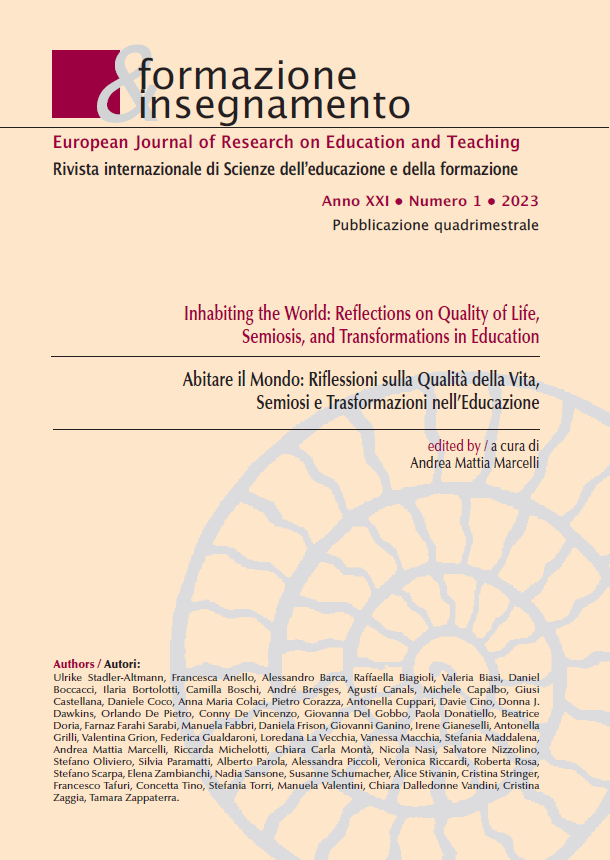Teacher’s Verbal Communication in the Use of Reciprocal Teaching for Reading Comprehension: An Exploratory Study
DOI:
https://doi.org/10.7346/-fei-XXI-01-23_09Keywords:
Reading comprehension, Reciprocal teaching, Verbal interaction, Communicative functions, Observation indicatorsAbstract
In primary school, particularly in grades 3, 4, and 5, many students struggle with comprehension difficulties when it comes to reading, as evident in scientific literature and national and international surveys. Reciprocal Teaching (RT) has emerged as a cooperative learning practice that effectively supports and enhances the understanding of written texts. This study involved 10 primary school teachers and 73 fifth-grade students who participated in a guided reading activity using RT. The researchers observed and analysed the verbal interactions within the classroom setting. Specifically, the focus was on examining the communicative functions employed by the teacher to enhance students' reading performance. The analysis of the teachers' actions encompassed the use of reading strategies, modelling techniques, and providing support for teamwork. The progress made by the students in terms of their comprehension of the text was assessed through the administration of two carefully constructed tests.
References
Bente, E. H. (2003). Listening comprehension and reading comprehension in poor decoders: Evidence for the importance of syntactic and semantic skills as well as phonological skills. Reading and Writing: An Interdisciplinary Journal, 16, 505–539. Retrieved December 30, 2022, from http://dx.doi.org/10.1023/A:1025521722900
Bertolini, C. (2018). Innovare la didattica è possibile: una ricerca-formazione nell’ambito della didattica della comprensione del testo. Giornale Italiano della Ricerca Educativa, 21, 173–187. Retrieved December 30, 2022, from https://hdl.handle.net/11380/1204662
Bertolini, C., & Cardarello, R. (2012). Leggere insieme per comprendere un testo: descrivere e valutare i processi comunicativi. Giornale Italiano della Ricerca Educativa, 5, 13–23. Retrieved December 30, 2022, from https://hdl.handle.net/11380/737061
Bond, G. L., Tinker, M. A., & Wasson, B. W. (1979). Reading Difficulties: Their Diagnosis and Correction (4th ed.). London: Prentice Hall.
Broek, P., Kendeou, P., Lousberg, S., & Visser, G. (2011). Preparing for reading comprehension: Fostering text comprehension skills in preschool and early elementary school children. International Electronic Journal of Elementary Education, 4, 259-268. Retrieved December 30, 2022, from https://eric.ed.gov/?id=EJ1068603
Calvani, A., & Chiappetta Cajola, L. (Eds.) (2019). Strategie efficaci per la comprensione del testo. Il Reciprocal Teaching. Firenze: SApIE.
Calvani, A., Fornili, F., & Serafini, M. T. (2018). Comprendere e riassumere testi. Il metodo del Reciprocal Teaching nella scuola primaria. Trento: Erickson.
Cardarello, R., & Bertolini, C. (2020). Didattiche della comprensione del testo. Metodi e strumenti per la scuola primaria. Roma: Carocci.
Collins, A., Brown, J. S., & Newman, S. E. (1995). L’apprendistato cognitivo, per insegnare a leggere, scrivere e a far di conto. In Pontecorvo, C., Ajello, A. M., & Zucchermaglio, C. (Eds.), I contesti sociali dell’apprendimento. Acquisire conoscenze a scuola, nel lavoro, nella vita quotidiana (pp. 181–231). Milano: LED.
Cornoldi, C., & Oakhill, J. (Eds.) (1996). Reading Comprehension Difficulties. Processes and Intervention. Mahwah, New Jersey: Erlbaum.
De Beni, R., & Pazzaglia, F. (1995). La comprensione del testo. Modelli teorici e programmi di intervento. Torino: UTET.
De Landsheere, G. (1979). Come si insegna. Analisi delle interazioni verbali in classe. Teramo: Giunti & Lisciani.
De Landsheere, G., & Delchambre, A. (1981). I comportamenti non verbali dell’insegnante. Teramo: Giunti & Lisciani.
De Mauro, T. (1994). Capire le parole. Roma-Bari: Laterza.
Erwanto, E., Sri Maryatmi, A., & Budiyanto, A. (2018). The Effects of Reciprocal Teaching Learning Strategy and Self efficacy on Learning Outcomes of Early Childhood (AUD) Mathematical Logic. Al-Jabar: Jurnal Pendidikan Matematika, 9(1), 41–50. http://dx.doi.org/10.24042/ajpm.v9il.2567
Franta, H., & Colasanti, A.R. (1991). L’arte dell’incoraggiamento. Roma: Carocci.
Islam, S (2020). Implementing Reciprocal Teaching Method in Improve the Students’ Reading Comprehension Ability. Eternal. English, Teaching, Learning & Research Journal, 6(1), 96–110. http://dx.doi.org/10.24252/Eternal.V61.2020.A9
Kelly, M., Moore, D.W., & Tuck, B.F. (1994). Reciprocal Teaching in a Regular Primary School Classroom. The Journal of Educational Research, 88(1), 53–61. http://dx.doi.org/10.1080/00220671.1994.9944834
Kendeou, P., Broek, P., Helder, A., & Karlsson, J. (2014). A cognitive view of reading comprehension: Implications for reading difficulties. Learning Disabilities Research & Practice, 29(1), 10–16. http://dx.doi.org/10.1111/ldrp.12025
Komariah, E., Ramadhona, P.A.R., & Silviyanti, T.M. (2015). Improving Reading Comprehension through Reciprocal Teaching Method. Studies in English Language Education, 2(2), 87–102. http://dx.doi.org/10.24815/siele.v2i2.2693
Lumbelli, L. (1981). Educazione come discorso. Quando dire è fare educazione. Bologna: Il Mulino.
Lumbelli, L. (1982). Psicologia dell’educazione. Comunicare a scuola. Bologna: Il Mulino.
Lumbelli, L. (Ed.) (1994). Pedagogia della comunicazione verbale. Milano: Angeli.
Lumbelli, L. (2009). La comprensione come problema. Il punto di vista cognitivo. Bari: Laterza.
Meister, C., & Rosenshine, B. (1993). Reciprocal teaching: A Review of 19 Experimental Studies. Review of Educational Research, 64, 479–530.
Okkinga, M., van Steensel, R., van Gelderen, A.J.S., & Sleegers, P.J.C. (2018). Effects of reciprocal teaching on reading comprehension of low-achieving adolescents. The importance of specific teacher skills. Journal of Research in Reading, 41(1), 20–41. http://dx.doi.org/10.1111/1467-9817.12082
Oczkus, L.D. (2018). Reciprocal Teaching at Work. Powerful Strategies and Lessons for Improving Reading Comprehension (3rd Ed.). Alexandria, VA: ASCD.
Palincsar, A.S. (1986). The Role of Dialogue in Providing Scaffolded Instruction. Educational Psychologist, 21, 73–98. http://dx.doi.org/10.1080/00461520.1986.9653025
Palincsar A.S., & Brown A.L., (1984). Reciprocal Teaching of Comprehension-Fostering and Comprehension-Monitoring Activities. Cognition and Instruction, 1(2), 117–175. http://dx.doi.org/10.1207/s1532690xci0102_1
Palincsar, A.S., Ransom, K., & Derber, S. (1988). Collaborative Research and Development of Reciprocal Teaching. Educational Leadership, 46(4), 37–40. https://soe.umich.edu/sites/default/files/2021-08/Palincsar_CV%202021.pdf
Santi, M. (1997). Discussione in classe e co-costruzione della conoscenza. Uno studio esplorativo. In N. Paparella & B. Vertecchi (Eds.), La ricerca didattica per la riforma della scuola. L’insegnante, la scuola, la didattica (pp. 75–95). Napoli: Tecnodid.Tarchi, C., & Pinto, G. (2016). Reciprocal Teaching: Analyzing Interactive Dynamics in the Co-Construction of a Text’s Meaning. The Journal of Educational Research, 109(5), 518-530. http://dx.doi.org/10.1080/00220671.2014.992583
Williams, J.A. (2010). Taking on the role of questioner: Revisiting reciprocal teaching. The Reading Teacher, 64(4), 278–281. http://dx.doi.org/10.2307/40962078
Downloads
Published
How to Cite
Issue
Section
License
Copyright (c) 2023 Francesca Anello

This work is licensed under a Creative Commons Attribution 4.0 International License.
Formazione & insegnamento is distributed under Attribution 4.0 International (CC BY 4.0).
For further details, please refer to our Repository & Archiving Policy, as well as our Copyright & Licensing Terms.





